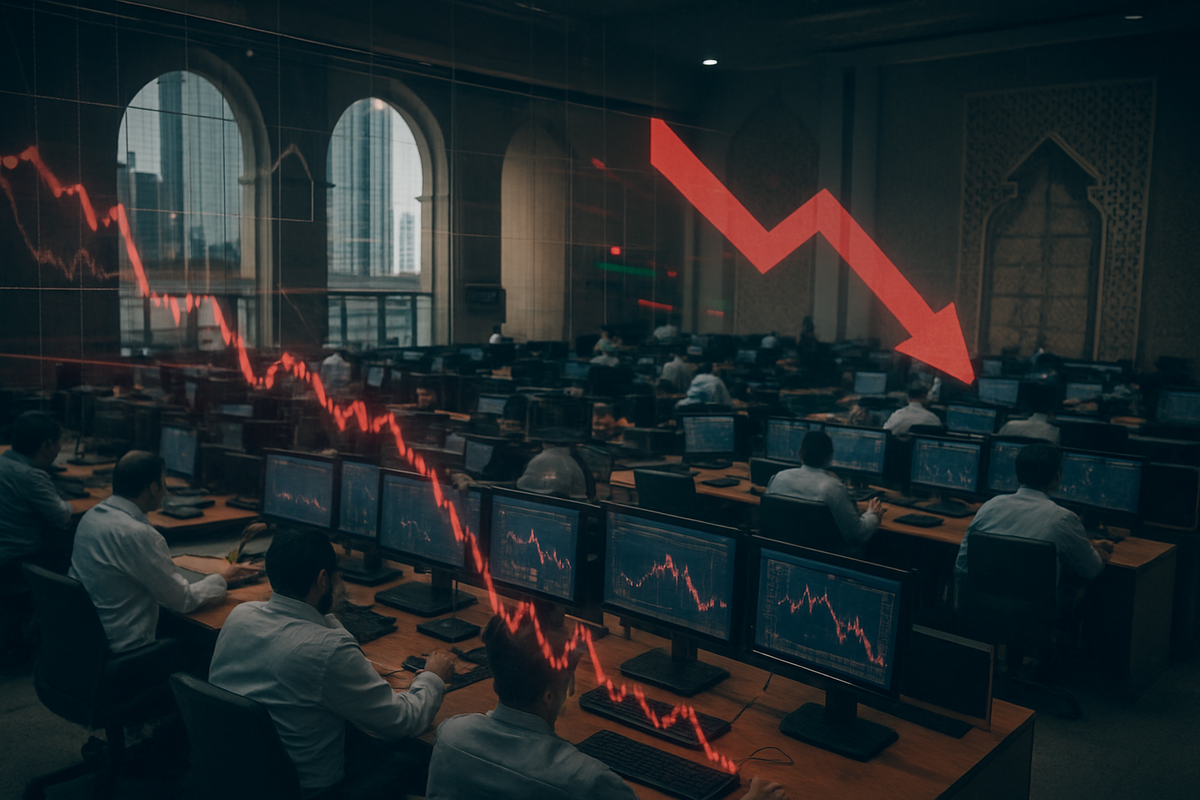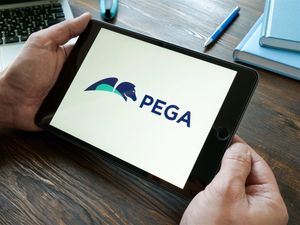
The Casablanca Stock Exchange (CSE) commenced trading lower on Friday, October 24, 2025, with its benchmark Moroccan All Shares Index (MASI) declining by 0.4% to 19,306.32 points. This subdued opening extended losses from the previous trading session and reflected a prevailing sense of caution and profit-taking among investors as the trading week drew to a close. The broad-based decline across major indices signals a period of market re-evaluation after a year of significant gains.
This downturn comes amidst a mixed performance throughout October, characterized by both sharp corrections and resilient rebounds. While the immediate implications point to heightened investor wariness, particularly concerning pending corporate reports and macroeconomic data, the underlying sentiment for the year remains largely bullish, supported by robust economic fundamentals and strong corporate earnings reported earlier in 2025.
Market Correction as Major Indices Slip
The market's performance on October 24, 2025, saw a collective downward movement across all major indices. The MASI 20, which tracks the 20 most liquid shares, declined by 0.38% to 1,574.42 points. Similarly, the MASI ESG index, reflecting companies with high environmental, social, and governance scores, dropped by 0.4% to 1,312.98 points, while the MASI Mid and Small Cap index, representing smaller listed firms, dipped by 0.43% to 1,903.29 points. This broad-based decline indicates a market-wide correction rather than an isolated sectoral issue.
Several heavyweight stocks contributed significantly to the overall market downturn. Notable declines included AtlantaSanad (CSE: ATN) which fell 3.7% to 152.05 dirhams, Minière Touissit (CSE: MTO) decreasing by 2.8% to 2,430 dirhams, and M2M Group (CSE: M2M) shedding 2.72% to 471.6 dirhams. Lesieur Cristal (CSE: LEC) lost 2.68% to 291 dirhams, and Société Métallurgique d'Imiter (SMI) (CSE: SMI) declined nearly 2% to 2,673 dirhams. These movements suggest that some of the market's leading companies are undergoing a period of correction or profit-taking after a robust year.
The immediate factors contributing to this cautious mood include widespread profit-taking by investors and sluggish trading volumes, typical as a trading week concludes. Analysts have also highlighted volatility in certain sectors, particularly insurance and industrial shares, as a factor dampening market confidence. Furthermore, there's an underlying anticipation of pending corporate reports and macroeconomic data, which could significantly influence near-term market trends. A marginal cooling in sentiment among foreign investors, who have adopted a "wait-and-see" approach, has also been noted, potentially impacting valuations and liquidity, especially in the banking, tourism, and real estate sectors.
Looking at the broader context of October 2025, the CSE has experienced a dynamic period. Early October saw significant losses, with the MASI decreasing by -3.44% on October 1st, following a turbulent late September marked by "Gen Z Protests" that weighed on investor confidence. However, the market also demonstrated resilience, with a rebound of 2.48% on October 3rd and further gains on October 13th and October 20th. Despite the recent corrections, the MASI maintained a strong year-to-date performance, up approximately 26.35% as of mid-October, outpacing most North African peers and reflecting a robust investor appetite for Moroccan equities driven by World Cup-related infrastructure spending, looser monetary policy, and strong first-half corporate earnings.
Companies Navigating the Downturn: Winners and Losers
The recent downturn at the Casablanca Stock Exchange, while a broad market movement, is expected to create distinct winners and losers among public companies, reflecting their sector, market capitalization, and operational resilience. This occurs even as Morocco's broader economic outlook remains robust, with the IMF and World Bank projecting a 4.4% GDP growth in 2025, driven by dynamic secondary and tertiary sectors and strong domestic demand. However, short-term market volatility can significantly impact individual firms.
Companies within the heavily weighted financial and real estate sectors are particularly vulnerable to the market's slide. Financial institutions like Attijariwafa Bank (CSE: ATW) and Banque Centrale Populaire (CSE: BCP), which comprise a significant portion of the MASI, are likely to face declining valuations, potentially increasing their borrowing costs and affecting capital-raising efforts. The insurance sector also feels the pinch, with AtlantaSanad (CSE: ATN) leading declines in late October 2025 with a 3.7% drop, indicative of investor caution. Similarly, real estate developers such as Douja Promotion Groupe Addoha (CSE: ADH) and Alliances Developpement Immobilier (CSE: ADI) are highly susceptible, given the existing slowdown in Morocco's real estate market, characterized by declining sales and rising construction costs. A stock market downturn could further dampen investor and consumer confidence, exacerbating these challenges.
The mining sector is another area likely to experience losses, being highly sensitive to global economic conditions and commodity prices. Minière Touissit (CSE: MTO) saw a 2.8% decline in late October, while Managem S.A. (CSE: MNG) also experienced a recent 1.70% drop. Deteriorating international economic conditions, often associated with a significant market downturn, could reduce foreign investor interest and depress commodity prices. Export-oriented industries, especially those tied to European demand, might also face headwinds. For instance, Lesieur Cristal (CSE: LEC), a consumer goods company, recorded a 2.68% loss in late October, suggesting vulnerability to market sentiment and factors affecting consumer spending or export markets.
Conversely, companies in defensive sectors or those with strong domestic foundations and essential services are poised for greater resilience. The healthcare, pharmaceutical, and chemical sectors generally exhibit stability due to inelastic demand. Akdital (CSE: AKD), a healthcare provider, despite some short-term fluctuations, is expected to be relatively resilient. Similarly, Sothema (CSE: SOT), a pharmaceutical company, operates in a sector that typically performs well during uncertainties. Maroc Telecom (CSE: IAM), a telecommunications giant, provides essential services and managed modest gains on days when the broader market slipped in October 2025, indicating investor confidence possibly linked to its broader African operations and strategic investments in 5G and fiber optics. Domestically focused consumer staples like Cosumar (CSE: CSR) (sugar production) and Société des Boissons du Maroc (CSE: SBM) (beverages) have also shown resilience, posting gains in early to mid-October, as demand for their products remains relatively stable. Furthermore, companies with niche markets or strong individual performances, such as Ib Maroc.com (CSE: IBM) and CFG Bank (CSE: CFG), managed to buck the overall market trend, indicating specific strengths or market positions that allow them to thrive even in challenging conditions.
Wider Significance: A Market in Correction, Not Crisis
The Casablanca Stock Exchange's (CSE) lower opening on October 24, 2025, with major indices slipping, carries a nuanced wider significance, pointing more towards a market correction and investor caution rather than a deep systemic crisis. This recent dip follows a period of substantial year-to-date gains, underpinned by Morocco's robust economic fundamentals.
This market behavior fits into several broader industry and economic trends. Firstly, Morocco's economy continues to demonstrate underlying strength, with GDP growth projected to reach 3.8% in 2025, fueled by increased investment, a recovering agricultural sector, and strong performance in tourism and industrial sectors like automotive and aeronautics. Easing inflation has also allowed the central bank, Bank Al-Maghrib, to continue its easing cycle with rate cuts, providing monetary support. Secondly, the correction aligns with a pattern seen across various emerging markets globally, where strong equity rallies often lead to periods of profit-taking—a natural aspect of market cycles. The "wait-and-see" stance adopted by foreign investors, despite Morocco's solid fundamentals, underscores the sensitivity of emerging markets to global economic conditions and localized volatility.
The ripple effects of a sustained or deepening downturn, while not immediately apparent, could include an erosion of investor confidence, particularly among domestic participants, potentially impacting market liquidity. It could also make it more challenging for Moroccan companies to raise capital through equity offerings, thereby affecting their expansion plans. Furthermore, a significant stock market decline, even if short-term, could be perceived externally as a sign of underlying economic fragility, potentially influencing foreign direct investment (FDI) inflows, which are currently robust. For domestic investors, especially retail and pension funds, a drop in stock values could lead to a negative wealth effect, potentially impacting consumption and saving patterns.
Morocco's robust financial stability framework is crucial in managing such market fluctuations. The country boasts a three-tiered system involving Bank Al-Maghrib (BAM), a cross-regulatory coordination committee, and a crisis management committee, designed to monitor risks and coordinate responses. With inflation easing, the central bank has flexibility for further monetary policy interventions to stimulate the economy. Additionally, supportive fiscal policies, including significant public investment in large-scale projects like infrastructure for the upcoming Africa Cup of Nations in 2025 and the World Cup 2030, act as a buffer against private sector slowdowns. The Moroccan Capital Markets Authority (AMMC) maintains regulatory oversight to ensure market integrity and investor protection.
Historically, the Casablanca Stock Exchange has navigated several significant downturns, offering valuable precedents. The 2008 Global Financial Crisis and subsequent Eurozone crisis led to a downturn, but Morocco's financial system demonstrated resilience due to a solid banking sector and a predominantly local investor base. The "Arab Spring" events in 2010 and the 2012-2013 downturn saw the market plummet, exacerbated by a lack of global liquidity and a downgrade by Standard and Poor's. More recently, the COVID-19 pandemic in March 2020 caused an "unprecedented panic," with the MASI experiencing its largest historical single-day decline. Even closer to the present, late September 2025 saw the MASI slip due to youth-led demonstrations (dubbed "GenZ212"), adding a psychological layer to profit-taking. These historical events highlight the market's sensitivity to both global economic shocks and domestic socio-political developments, yet also its underlying resilience.
What Comes Next: Navigating Volatility Towards Long-Term Growth
The recent lower opening of the Casablanca Stock Exchange, marked by slipping major indices, signals a period of short-term volatility and investor caution. However, this appears to be a correction within a fundamentally bullish market, driven by Morocco's robust economic outlook and strategic national initiatives. The coming months will be crucial for the market to re-establish its trajectory.
In the short term, the CSE is likely to experience continued volatility. The recent profit-taking and cautious investor sentiment suggest that the market might oscillate as investors digest new corporate earnings and macroeconomic data. Further periods of profit-taking are possible, especially in sectors that have seen rapid growth, leading to potential sectoral shifts as investors reallocate capital to more resilient or undervalued areas. External factors, such as global economic headwinds (e.g., rising protectionism, debt risks), and domestic events, like the youth-led protests observed in late September, could also briefly weigh on confidence. However, the market's strong year-to-date performance, which saw the MASI index up over 26% by mid-October, suggests that these dips are likely technical corrections rather than the onset of a prolonged downturn.
Looking at the long term, the outlook for the Casablanca Stock Exchange remains fundamentally positive. This optimism is underpinned by several key drivers: Morocco's co-hosting of the 2025 Africa Cup of Nations and the 2030 FIFA World Cup is expected to provide sustained impetus, attracting significant public and private investments, particularly for sectors like construction, tourism, and manufacturing. The Moroccan economy continues to exhibit robust growth, with the IMF forecasting a 3.9% GDP growth for 2025, supported by a recovering agricultural sector and strong domestic demand. Corporate profitability has also been strong, with combined profits of listed companies jumping 48.2% in the first half of 2025, a trend expected to continue. Increased liquidity from a tax amnesty program and growing retail investor participation further support the long-term growth narrative.
To capitalize on these opportunities and mitigate challenges, the Casablanca Stock Exchange and Moroccan authorities are implementing several strategic pivots. These include developing a comprehensive market infrastructure with a central counterparty and a derivatives market, and introducing innovative financial instruments such as Real Estate Investment Trusts (REITs), Sukuks, green bonds, and project bonds to diversify funding sources. The exchange also aims to significantly increase the number of listed companies from 77 to 300 by 2035, offering simplified procedures and reduced listing costs for small and medium businesses. Enhancing investor confidence through financial transparency and corporate governance, alongside solidifying Morocco's position as a regional trade and financial hub through initiatives like Casablanca Finance City, are also key strategic objectives.
Despite these promising opportunities, challenges persist. Market concentration in banking and real estate (over 60% of market capitalization) makes the CSE vulnerable to sector-specific shocks. The scarcity of new IPOs remains a hurdle, with many smaller companies preferring bank loans over listing due to transparency concerns. Global economic headwinds and domestic vulnerabilities like severe water shortages and persistent youth unemployment also pose long-term risks. Ultimately, the most likely scenario for the CSE is a resilient recovery, where recent dips are seen as minor technical corrections within a fundamentally bullish market, supported by robust economic growth and sustained investment. However, a prolonged period of volatility or even a significant downturn could occur if global economic uncertainty intensifies or domestic challenges are not effectively addressed.
Wrap-Up: A Resilient Market Navigating Correction
The Casablanca Stock Exchange's lower opening on October 24, 2025, with major indices slipping, serves as a key reminder of market dynamics and the natural ebb and flow of investor sentiment. While the immediate reaction points to profit-taking and caution, the broader context of Morocco's robust economic fundamentals and strategic growth initiatives suggests that this is likely a healthy market correction rather than a signal of deep distress.
The key takeaway is that despite short-term volatility, the Moroccan market is supported by strong economic growth projections for 2025 and 2026, easing inflation, and a proactive central bank. Major catalysts like the 2030 FIFA World Cup and significant investments in infrastructure, tourism, and manufacturing are poised to drive sustained growth. However, challenges such as market concentration, the difficulty in attracting new IPOs, and external economic headwinds remain pertinent.
For investors, the coming months call for a strategic and long-term perspective. Panic selling should be avoided, and instead, this period could be an opportune time to revisit and diversify portfolios, focusing on defensive stocks and companies with strong fundamentals. Strategies like dollar-cost averaging can help mitigate risk and capitalize on potential buying opportunities.
What to Watch For in Coming Months:
- Corporate Earnings Reports: These will offer crucial insights into company performance.
- Macroeconomic Data: Key indicators like inflation, GDP growth revisions, and unemployment figures for Morocco.
- Global Economic Developments: Global trade relations, economic growth in the European Union, and geopolitical events.
- Government Policy and Investment Initiatives: Progress of major infrastructure projects and new policies aimed at stimulating the economy.
- Banking Sector Performance: Given its significant weight, the health of the banking sector will be a critical indicator for the overall market.
In conclusion, while the recent opening lower on the Casablanca Stock Exchange may cause short-term concern, it aligns with the natural ebb and flow of market corrections. Morocco's promising economic trajectory and ongoing structural reforms suggest a foundation for potential recovery, making a discerning and patient investment approach crucial for navigating the coming months.
This content is intended for informational purposes only and is not financial advice





